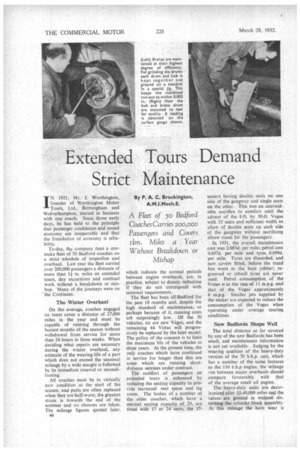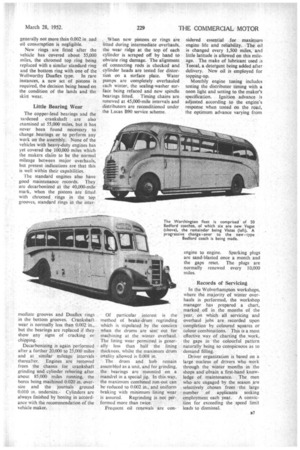Extended Tours Demand Strict Maintenance
Page 40

Page 41

If you've noticed an error in this article please click here to report it so we can fix it.
By P. A. C. Brockington, A.M.I.Mech.E. IN 1921, Mr. J. Worthington, founder of Worthington Motor Tours, Ltd., Birmingham and Wolverhampton, started in business with one coach. Since those early days, he has held to the principle that passenger confidence and sound economy are inseparable and that the foundation of economy is reliability.
To-day, the company runs a onemake fleet of 50 Bedford coaches on a strict schedule of inspection and overhaul. Last year the fleet carried over 200,000 passengers a distance of more than 11 m. miles on extended tours, day excursions and contract work without a breakdown or mishap. Many of the journeys were on the Continent.
The Winter Overhaul
On the average, coaches engaged on tours cover a distance of 27,000 miles in the year and must be capable of running through the busiest months of the season without withdrawal from service for more than 24 hours in three weeks. When deciding what repairs are necessary during the winter overhaul, any estimate of the wearing life of a part which does not exceed the seasonal mileage by a wide margin is followed by its immediate renewal or reconditioning.
All coaches must be in virtually new condition at the start of the season, and parts are often replaced when they are half-worn; the greatest strain is towards the end of the summer and no chances are taken. The mileage figures quoted later, a6 which indicate the normal periods between engine overhauls, are, in practice, subject to drastic reduction if they do not correspond with seasonal requirements.
The fleet has been all-Bedford for the past 18 months and, despite the high standard of maintenance, or perhaps because of it, running costs are surprisingly low. Of the 50 vehicles, six are new Vegas, and the remaining 44 Vistas will progressively be replaced by the later model. The policy of the concern is to limit the maximum life of the vehicles to three years. At the present time, the only coaches which have continued in service for longer than this are some which are running shortdistance services under contract.
The comfort of passengers on extended tours is enhanced by reducing the seating capacity to provide increased seat space and leg room. The bodies of a number of the older coaches, which have a normal seating capacity of 29, are fitted with 17 or 24 seats, the 17
seaters having double seats on one side of the gangway and single seats on the other. This was an unavoidable sacrifice to comfort until the advent of the 8-ft. by 30-ft. Vegas with 35 seats and sufficient width to allow of double seats on each side of the gangway without sacrificing elbow room for the passengers.
In 1951, the overall maintenance cost was 2.683d, per mile; petrol cost 4.607d. per mile and tyres, 0.699d. per mile. Tyres are discarded; and new covers fitted, before the tread has worn to the base rubber; regrooved or rebuilt tyres are never used. Petrol consumption, of the Vistas is at the rate of 11 .m.p.g. and that of the Vegas approximately 8 m.p.g. Smaller jets supplied by
• the maker are expected to reduce the consumption of the Vegas when operating under average touring conditions.
New Bedfords Shape Well The total distance so far covered by any of the new Bedfords has been small, and maintenance information is not yet available. Judging 'by the wearing qualities of the heavy-duty version of the 70 b.h.p. unit, which has a number of the same features as the 110 b.h.p engine, the mileage run between major overhauls should compare favourably with that of the average small oil engine.
The heavy-duty units are decarbonized after 35-40,000 miles and the valves are ground in without disturbing the cylinder-block assembly. At this mileage the bore wear is generally not more than 0.002 in and oil consumption is negligible.
New rings are fitted after the vehicle has covered about 55,000 miles, the chromed top ring being replaced with a similar standard ring and the bottom ring with one of the Wel!worthy Duaflex type. In rare instances, a new set of pistons is required, the decision being based on the condition of the lands and the skirt wear.
Little Bearing Wear
The copper-lead bearings and the lardened crankshaft are also examined at 55,000 miles, but it has never been found necessary to change bearings or to perform any work on the assembly. None of the vehicles with heavy-duty engines has yet covered the 100,000. miles which the makers claim to be the normal mileage between major overhauls, but present indications are that this is well within their capabilities.
The standard engines also have good maintenance records. They are decarbonized at the 40,000-mile mark, when the pistons are fitted with chromed rings in the top grooves, standard rings in the inter mediate grooves and Duallex rings in the bottom grooves. Crankshaft wear is normally less than 0.002 in., but the bearings are replaced if they show any signs of cracking or chipping.
Decarbonizing is again performed after a further 20,000 to 25,000 miles and at similar mileage intervals thereafter. Engines are removed from the chassis for crankshaft grinding and cylinder reboring after about 85,000 miles running, tne bores being machined 0.020 in. oversize and the journals ground 0.010 in.• undersize.. Cylinders are always finished by honing in accordance with the recommendation of the vehicle maker.
When new pistons or rings are fitted during intermediate overhauls, the wear ridge at the top of each cylinder is scraped off by hand to obviate ring damage. The alignment of connecting rods is checked and cylinder heads are tested for distortion on a surface plate. Water pumps are completely overhauled each winter, the scaling-washer surface being refaced and new spindle hearings fitted. Timing chains are renewed at 45,000-mile intervals and distributors are reconditioned under the Lucas B90 service scheme.
Of particular interest is the method of brake-drum regrinding which is stipulated by the concern when the drums are sent out for machining at the winter overhaul. The lining wear permitted is generallyless than half the lining thickness, whilst the maximum drum ovality allowed is 0.008 in.
The drum and hub remain assembled as a unit, and for grinding, the bearings are mounted on a mandrel in a special jig.. In this way, the maximum combined run-out can be reduced to 0.002 in., and uniform braking with minimum lining wear
is assured. Regrinding is not performed more than twice.
Frequent oil renewals are con sidered essential for maximum engine life and reliability. The oil is changed every 1,500 miles, and little latitude is allowed on this mileage. The make of lubricant used is Teecal, a detergent being added after delivery. New oil is employed for topping-up.
Monthly engine tuning includes testing the distributor timing with a neon light and setting to the maker's specification. Ignition advance is adjusted according to the engine's response when tested on the road, the optimum advance varying from
engine to engine. Sparking plugs are sand-blasted once a month and the gaps reset. The plugs are normally renewed every 10,000 miles.
Records ofServicing
In the Wolverhampton workshops, where the majority of winter overhauls is performed, the workshop manager has prepared a chart, marked off in the months of the year, on which all servicing and overhaul jobs are recorded upon completion by coloured squares or colour combinations. This is a most effective way of charting the work, the gaps in the colourful pattern naturally being so conspicuous as to demand filling.
Driver organization is based on a large nucleus of drivers who work through the winter months in the shops and obtain a first-hand knowledge of maintenance. The men who are engaged by the season are selectively . chosen from the large number of applicants seeking employment each year. A conviction for exceeding the speed limit leads to dismissal.




















































































